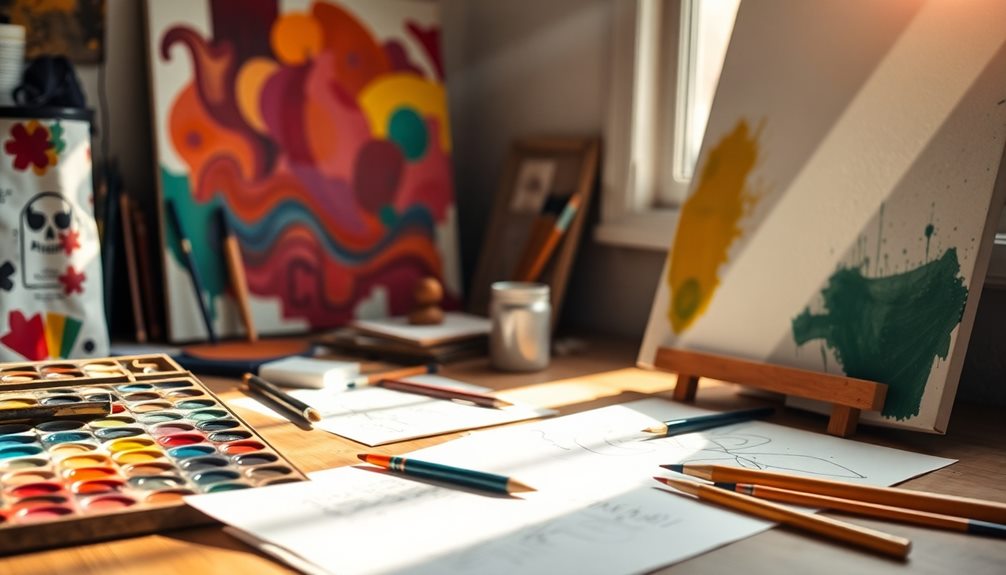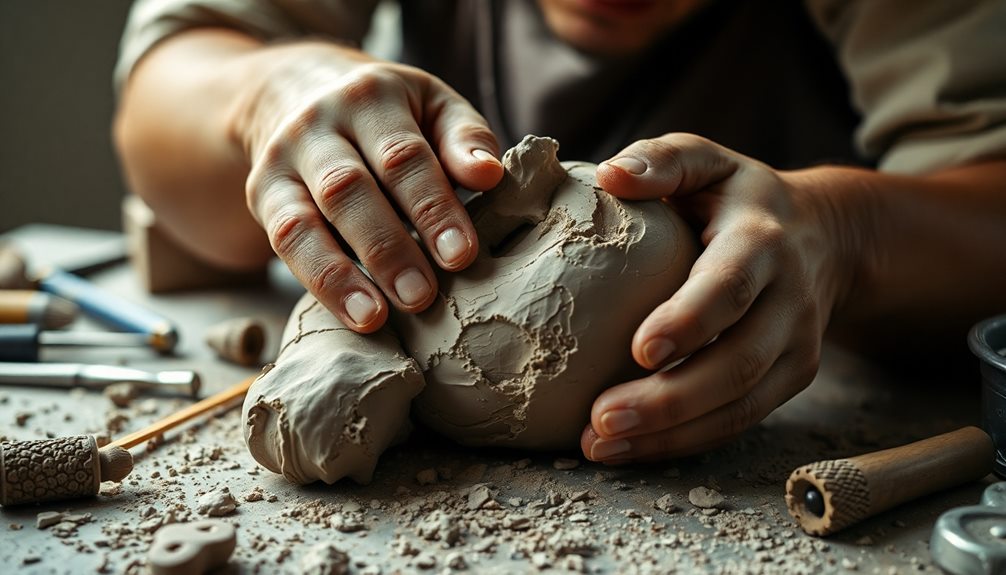To write about paintings effectively, start with close observation. Look at the composition, colors, and techniques used. Analyze the subject matter and consider the artist's background for context. Incorporate precise art terminology to express your thoughts clearly. Reflect on your emotional responses and ask yourself critical questions about the piece. This approach will help you uncover deeper meanings and themes. Remember, engaging with the historical and cultural influences of the artwork can enhance your interpretation. By following these steps, you'll gain a richer understanding that can guide you through the complexities of art analysis.
Key Takeaways
- Begin with close observation of visual elements like composition, color, and technique to analyze the painting effectively.
- Incorporate historical and cultural context to understand the artist's intent and the artwork's significance.
- Utilize precise art terminology to articulate observations and enhance communication of your analysis.
- Reflect on personal emotions and interpretations, recognizing that responses to art can vary among individuals.
- Structure your writing logically, supporting claims with evidence and revising for clarity and coherence.
Introduction

Writing about paintings requires a thoughtful approach that dives into the artwork's essence. You'll begin your art analysis by closely observing the visual elements—composition, color, and technique. These aspects aren't just decorative; they convey deeper meanings and emotions. When you describe the painting, focus on what stands out and how it makes you feel. This detailed description sets the stage for a more profound understanding.
Additionally, consider how imagination plays a role in the creation of art, as it allows artists to explore personal experiences and cultural narratives, highlighting the importance of imagination in artistic expression.
Context is crucial. Consider the artist's background, the historical significance of the piece, and its intended audience. This information enriches your formal analysis and helps you connect the artwork to broader themes and ideas. Using precise art terminology is essential; it allows you to articulate your observations clearly and professionally.
As you engage with the artwork, let your personal reflections guide your exploration. Critical questioning can lead you to deeper interpretations, allowing you to uncover connections between the painting and your own experiences.
Key Concepts and Definitions

Understanding key concepts and definitions is essential for effectively analyzing and discussing paintings. To provide a comprehensive analysis, you need to grasp the elements of art—like line, shape, color, texture, and space—and how they contribute to the overall composition.
In addition, incorporating techniques for maintaining motivation can enhance your engagement with the artwork, encouraging deeper exploration of its themes and techniques. The subject matter, or the content depicted in the artwork, plays a crucial role in shaping your understanding, as it provides insights into the artist's intent.
Familiarizing yourself with art terminology, such as "color harmony" and "linear perspective," will enhance your ability to articulate observations. Knowing the definitions of key terms allows you to communicate your thoughts clearly. For instance, the emotional tone of a painting can be described using specific adjectives, enriching your critique and helping readers connect with the artwork's impact.
Context is another vital aspect to consider. Analyzing the historical, cultural, and social influences surrounding a painting can deepen your understanding and interpretation.
Essential Analysis Techniques

When analyzing a painting, employing essential techniques can significantly enhance your insights. Start with visual analysis by examining the composition, colors, and techniques the artist used.
Look closely at the elements of the work, such as line, shape, and color, and consider how these components work together to convey a message. Additionally, understanding the impact of topical authority's role in art criticism can provide a deeper appreciation of the painting's significance and the artist's intention.
Next, analyze the subject matter. Distinguish between realism and abstraction, and try to interpret the artist's intent.
Consider any underlying messages that might inform the viewer's understanding. This step is crucial for grasping the deeper significance of the artwork.
Don't forget to delve into contextual analysis as well. Explore the historical, cultural, and social context surrounding the painting; these influences can deeply impact its meaning.
Real-World Artwork Analysis

A thorough analysis of real-world artwork demands careful observation of its visual elements, such as line, color, and texture, which all contribute to the overall composition and emotional impact.
When engaging in the analysis of the artwork, start by identifying these elements and how they interact with one another. Consider the historical and cultural context of the piece; understanding the time period can provide critical insights into the artist's intent and the themes explored.
Next, assess whether the artwork leans towards realism or abstraction, as this distinction heavily influences your interpretation and emotional response.
A structured approach focusing on principles like balance, emphasis, and unity can deepen your understanding and appreciation of the work. Additionally, comparing the artwork to other pieces within the same genre or movement can reveal broader trends in artistic expression, shedding light on its significance in a wider context.
Tips and Best Practices

To effectively write about paintings, focus on using clear and precise language that captures the visual elements. Start by analyzing visual aspects like composition and technique, as these are crucial in conveying the artist's intent. Pay attention to the use of color—how it influences mood and highlights important details within the artwork.
As you write, incorporate the historical and cultural context surrounding the piece. This adds depth and helps your readers understand why the painting is significant. Discuss specific emotions or themes evoked by the artwork, ensuring you support your observations with evidence drawn directly from the painting itself.
Structure your writing logically. Begin with an introduction that outlines your main points, proceed to detailed analysis, and wrap up with a summary of your insights.
Don't forget to revise your work multiple times; clarity and coherence are key. Reading your piece aloud can help you catch awkward phrasing or unclear statements, ensuring your writing remains engaging.
Audience Engagement With Art

Engaging with art isn't just about observing; it's about forming personal connections that enrich your experience. When you take the time to reflect on a piece, you might find that your emotions and experiences influence your interpretation. This personal projection can deepen your appreciation and understanding of the artwork's overall effect.
Asking open-ended questions while you observe can encourage deeper reflection. What feelings does the visual evoke? How does the color palette resonate with your personal experiences? These questions can lead to meaningful dialogue, enhancing your connection to the art.
Participating in interactive experiences, like guided tours or workshops, makes art more relatable and accessible. These settings invite you to actively engage, rather than passively consume.
Don't underestimate the power of social media, either. Sharing your personal responses to artwork can cultivate a community of dialogue and exchange, extending your engagement beyond the gallery walls.
Lastly, multimedia elements—like videos or audio guides—can provide enriching context and emotional resonance, further enhancing your engagement. By connecting on various levels, you can truly appreciate the depth and beauty that art offers.
Artistic Intent and Interpretation

Understanding artistic intent and interpretation can transform how you perceive a painting. Artistic intent refers to the purpose and message the artist aims to convey, shaped by personal experiences, cultural context, and historical events.
When you examine a painting, consider the formal elements like color, line, and composition. These aspects not only enhance the artwork's aesthetic but also serve as clues to the artist's intentions.
Your interpretation involves analyzing these visual elements and the subject matter to uncover deeper meanings that might differ from the artist's original intent. Keep in mind that context plays a crucial role; the socio-political climate and the artist's background significantly influence both the artistic intent and your interpretation.
Engage critically with the artwork by reflecting on your emotional responses. Ask yourself how these feelings connect to broader themes or societal issues depicted in the painting.
Recognizing the interplay between artistic intent and viewer interpretation fosters a more nuanced appreciation of art. It highlights that meaning can evolve over time and through different cultural lenses, enriching your experience and understanding of the artwork.
Additional Resources

Numerous resources are available to enhance your exploration of paintings and deepen your analytical skills. Start by utilizing online databases like Art Index, RILA, and the Avery Index to find scholarly articles and research material relevant to your piece. These platforms can help you learn something new about various interpretations and critiques.
To strengthen your understanding of color theory, consider exploring resources such as "Understanding the Color Blue and Its Shades." This knowledge will refine your ability to analyze the focal point of a painting effectively.
Additionally, reading "Captivating Cultural Expressions" can provide you with insights into diverse artistic perspectives, especially from Hispanic artists, broadening your appreciation of cultural contexts.
Don't overlook guides that discuss the different painting mediums, including acrylic, tempera, oil, and watercolor. Understanding these technical aspects will enhance your critiques.
Frequently Asked Questions
How Do You Write About a Painting?
To write about a painting, start by observing it closely. Capture your initial impressions, then analyze elements like color and composition. Finally, synthesize your thoughts into a cohesive interpretation that highlights its significance and emotional impact.
How Do You Start Writing About Art?
To start writing about art, observe it closely and jot down your impressions. Identify key elements like color and shape. Research the artist's background, then formulate a thesis that captures your interpretation.
How to Explicate an Artwork Step by Step?
To explicate an artwork, start by observing its overall composition. Identify formal elements like line and color. Research the artist's background, analyze techniques, and synthesize your findings to articulate the artwork's significance and meaning.
What Are the Four Main Steps in Writing About a Work of Art?
To write about a work of art, you'll observe its elements, analyze the formal aspects, contextualize its background, and interpret its emotional themes. These steps help you articulate the significance and impact of the artwork.
Conclusion
In conclusion, writing about paintings can be both rewarding and insightful. By understanding key concepts, employing effective analysis techniques, and engaging with your audience, you'll enhance your appreciation of art. Remember to consider the artist's intent and embrace your own interpretation. With practice, you'll develop your unique voice, allowing you to share the beauty and complexity of paintings with others. So grab your pen, and start exploring the world of art through your words!









